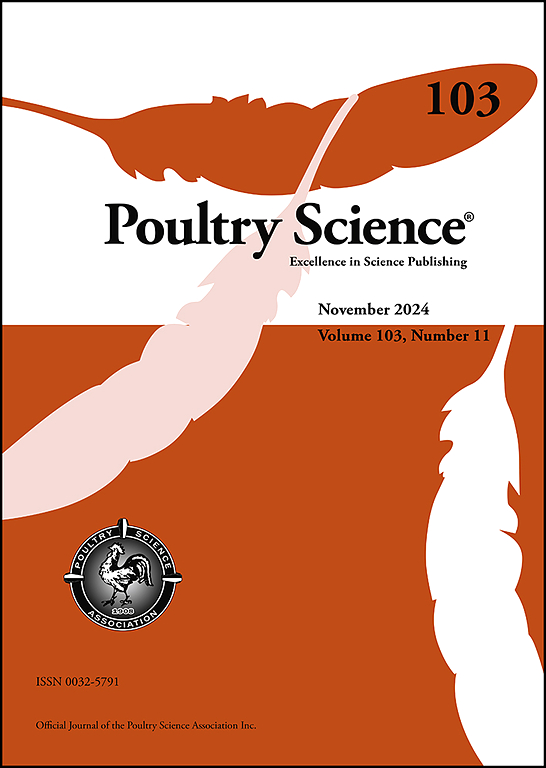10,12-共轭亚油酸通过ERK1/2-AMPK途径减轻原代鸡肝细胞的脂质积累。
IF 4.2
1区 农林科学
Q1 AGRICULTURE, DAIRY & ANIMAL SCIENCE
引用次数: 0
摘要
共轭亚油酸(CLA)异构体有减轻动物体重和促进糖脂代谢的作用。在初步研究中,我们发现反式-10,顺式-12-CLA (10,12- cla)在调节鸡脂质代谢中起重要作用。然而,其潜在机制尚不清楚。本研究采用原代鸡肝细胞构建离体模型,研究10,12- cla对鸡脂质代谢的影响。10,12- cla通过降低甾醇调节元件结合蛋白-1c (SREBP-1c)、srebp - p2、3-羟基-3-甲基戊二酰辅酶a还原酶(HMGCR)、脂肪酸合成酶(FAS)、脂肪三酰基甘油酯脂肪酶(ACC)和脂蛋白脂肪酶(LPL) mRNA表达以及增加过氧化物酶体增殖物激活受体α (PPARα)、肉毒碱棕榈酰基转移酶1 (CPT1)和脂肪三酰基甘油酯脂肪酶(ATGL) mRNA表达来抑制脂质积累。此外,10,12- cla处理激活了细胞外信号调节激酶1/2 (ERK1/2)和amp活化蛋白激酶(AMPK)的蛋白表达,而ERK1/2抑制剂U0126处理通过阻断ERK1/2-AMPK途径逆转了10,12- cla对脂质积累的抑制作用,导致原代鸡肝细胞中脂质积累和甘油三酯含量增加。上述结果提示,在鸡肝细胞中,10,12- cla通过激活ERK1/2-AMPK通路,促进脂肪酸氧化,减少脂质合成,减轻肝细胞脂质沉积,揭示了10,12- cla调节鸡肝脏脂质代谢的潜在机制。本文章由计算机程序翻译,如有差异,请以英文原文为准。
10,12-Conjugated linoleic acid alleviates lipid accumulation in primary chicken hepatocytes via the ERK1/2-AMPK pathway
Conjugated linoleic acid (CLA) isomers have been reported to reduce body weight and promote glycolipid metabolism in animals. In a preliminary study, we revealed that trans-10, cis-12-CLA (10,12-CLA) plays an important role in modulating lipid metabolism in chickens. However, the underlying mechanism remains unclear. In this study, we constructed an isolated in vitro model with primary chicken hepatocytes to investigate the effect of 10,12-CLA on lipid metabolism. 10,12-CLA inhibited lipid accumulation by decreasing the mRNA expression of sterol regulatory element-binding protein-1c (SREBP-1c), SREBP2, 3‑hydroxy-3-methylglutaryl-CoA reductase (HMGCR), fatty acid synthase (FAS), adipose triacylglyceride lipase (ACC), and lipoprotein lipase (LPL) and increasing the mRNA expression of peroxisome proliferator-activated receptor α (PPARα), carnitine palmitoyltransferase 1 (CPT1) and adipose triacylglyceride lipase (ATGL). Furthermore, 10,12-CLA treatment activated the protein expression of extracellular signal-regulated kinase 1/2 (ERK1/2) and AMP-activated protein kinase (AMPK), whereas treatment with the ERK1/2 inhibitor U0126 reversed the inhibitory effects of 10,12-CLA on lipid accumulation by blocking the ERK1/2-AMPK pathway, leading to increased lipid accumulation and triglyceride content in primary chicken hepatocytes. These findings suggest that in chicken hepatocytes, 10,12-CLA alleviates hepatocyte lipid deposition by activating the ERK1/2-AMPK pathway, promoting fatty acid oxidation and reducing lipid synthesis, revealing the potential mechanism through which 10,12-CLA regulates hepatic lipid metabolism in chickens.
求助全文
通过发布文献求助,成功后即可免费获取论文全文。
去求助
来源期刊

Poultry Science
农林科学-奶制品与动物科学
CiteScore
7.60
自引率
15.90%
发文量
0
审稿时长
94 days
期刊介绍:
First self-published in 1921, Poultry Science is an internationally renowned monthly journal, known as the authoritative source for a broad range of poultry information and high-caliber research. The journal plays a pivotal role in the dissemination of preeminent poultry-related knowledge across all disciplines. As of January 2020, Poultry Science will become an Open Access journal with no subscription charges, meaning authors who publish here can make their research immediately, permanently, and freely accessible worldwide while retaining copyright to their work. Papers submitted for publication after October 1, 2019 will be published as Open Access papers.
An international journal, Poultry Science publishes original papers, research notes, symposium papers, and reviews of basic science as applied to poultry. This authoritative source of poultry information is consistently ranked by ISI Impact Factor as one of the top 10 agriculture, dairy and animal science journals to deliver high-caliber research. Currently it is the highest-ranked (by Impact Factor and Eigenfactor) journal dedicated to publishing poultry research. Subject areas include breeding, genetics, education, production, management, environment, health, behavior, welfare, immunology, molecular biology, metabolism, nutrition, physiology, reproduction, processing, and products.
 求助内容:
求助内容: 应助结果提醒方式:
应助结果提醒方式:


